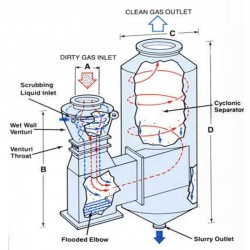Scrubbers are devices that use a liquid (often water) to capture and remove pollutants. Through a nozzle or orifice a scrubbing liquid is atomized and dispersed into the gas stream. The droplets entrain and capture dust particles through agglomeration, adherence, or encapsulation. This effectively increases the size and mass of the particles, making them easier to collect in a subsequent filter or separation process. The scrubbing liquid simultaneously absorbs and neutralizes gaseous pollutants. Suspended liquid is typically recovered in mist collectors and recycled through the system.
Many air scrubbers, wet scrubbers, and gas scrubbers are available with pre-filters or final filters to further reduced emissions. Pre-filters are installed upstream of the scrubber intended to catch larger particles. While the scrubber itself would be able to remove these larger particulates as well, their removal allows the scrubber to be designed to focus more keenly and effectively on smaller particulates. A final filter is often installed downstream of the scrubber, and is intended to catch fine particles that were not removed during the scrubbing process.
A key parameter in the design of scrubbers is the liquid-to-gas ratio (L/G). It is commonly expressed in gallons per minute (gpm) of liquid divided by actual cubic feet per minute (acfm) of gas. This ratio is determined by the solubility of the gas pollutants, the abundance of pollutants and particulate matter in the gas stream, and the mass transfer characteristics of the tower. Increasing (L/G) increases the collection efficiency of the system, so finding the optimum ratio is important for balancing performance with operating costs.
Types of Scrubbers
There are a number of different types of scrubbers which vary in terms of both function and performance.
Spray Towers
In spray towers or spray chambers, gas streams are fed into a chamber and contacted with scrubbing liquid produced by spray nozzles. The droplet size is controlled to optimize particle contact and droplet separation from the gas stream. Chambers can be oriented for cross-flow, countercurrent flow, or concurrent (co-current) flow. Chambers may also include baffles to improve gas-liquid contact.
Spray towers have low power consumption but have relatively low particulate collection efficiencies. The re circulated water in the system must be thoroughly cleaned to prevent excessive nozzle fouling or clogging. Nozzle cleaning and replacement are a major part of the maintenance required for these units.
Venturi Scrubbers
Venturi scrubbers are scrubbers with a venturi shaped chamber with converging and diverging sections. Water is injected at low pressure into the throat of the venturi through which the gas stream passes at high velocities. The energy from the gas atomizes the liquid, allowing particles and pollutants to be entrained in droplets. Venturi jet scrubbers use a modified design in which liquid is injected into the throat at high velocity rather than the gas stream.
Venturi scrubbers have high collection efficiencies for particulate pollution and are simple to install and maintain. However, they require large pressure drops leading to higher power requirements than other scrubber designs. Venturi jet scrubbers have lower pressure drops than typical venturi scrubbers.
Cyclone Spray Chambers
Cyclone spray chambers are scrubbers which combine the capture techniques of cyclones and spray towers. Gas streams typically enter into the chamber tangentially at high speeds. The high speeds induce cyclonic action, and the centrifugal force from this promotes droplet separation, allowing the use of a smaller droplet size which increases collection efficiency.
Cyclone spray chambers are more efficient than spray towers and have lower liquid requirements, but require more power due to higher pressure drops. They are preferred over spray towers for gas streams with heavier particulate loads.
Cyclone Spray Chambers
Cyclone spray chambers are scrubbers which combine the capture techniques of cyclones and spray towers. Gas streams typically enter into the chamber tangentially at high speeds. The high speeds induce cyclonic action, and the centrifugal force from this promotes droplet separation, allowing the use of a smaller droplet size which increases collection efficiency.
Cyclone spray chambers are more efficient than spray towers and have lower liquid requirements, but require more power due to higher pressure drops. They are preferred over spray towers for gas streams with heavier particulate loads
